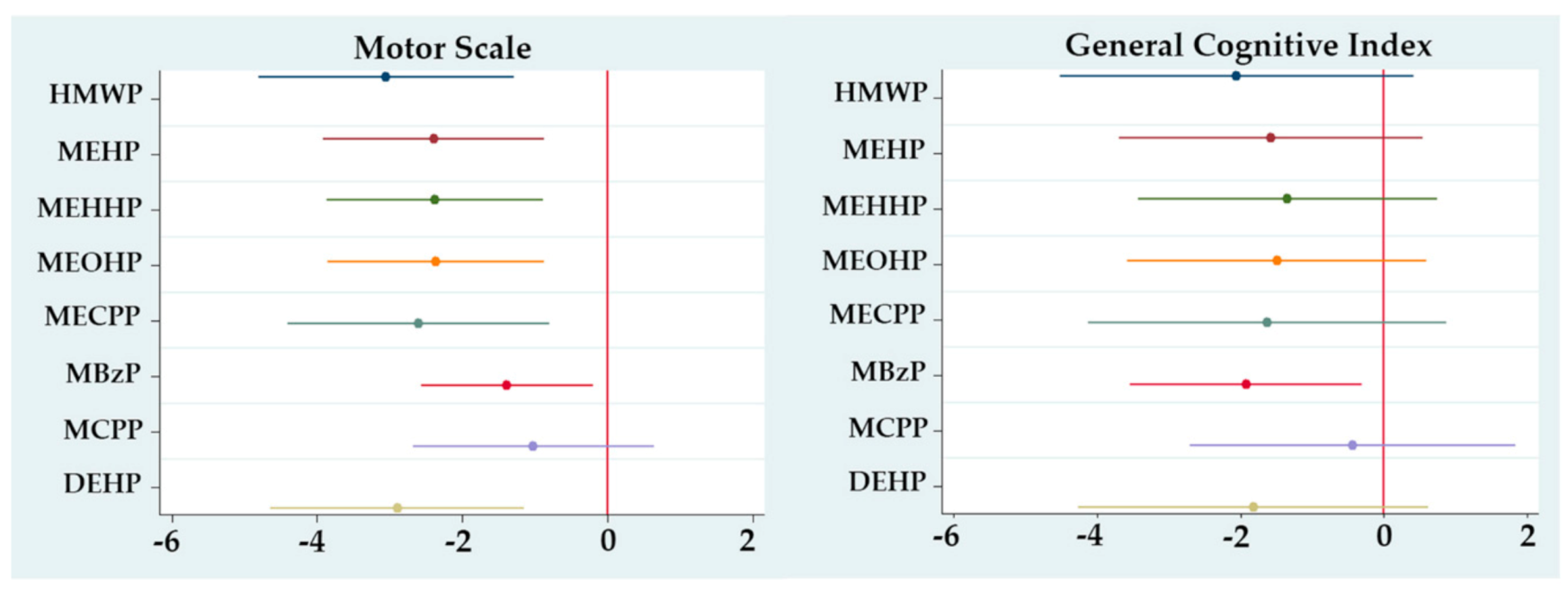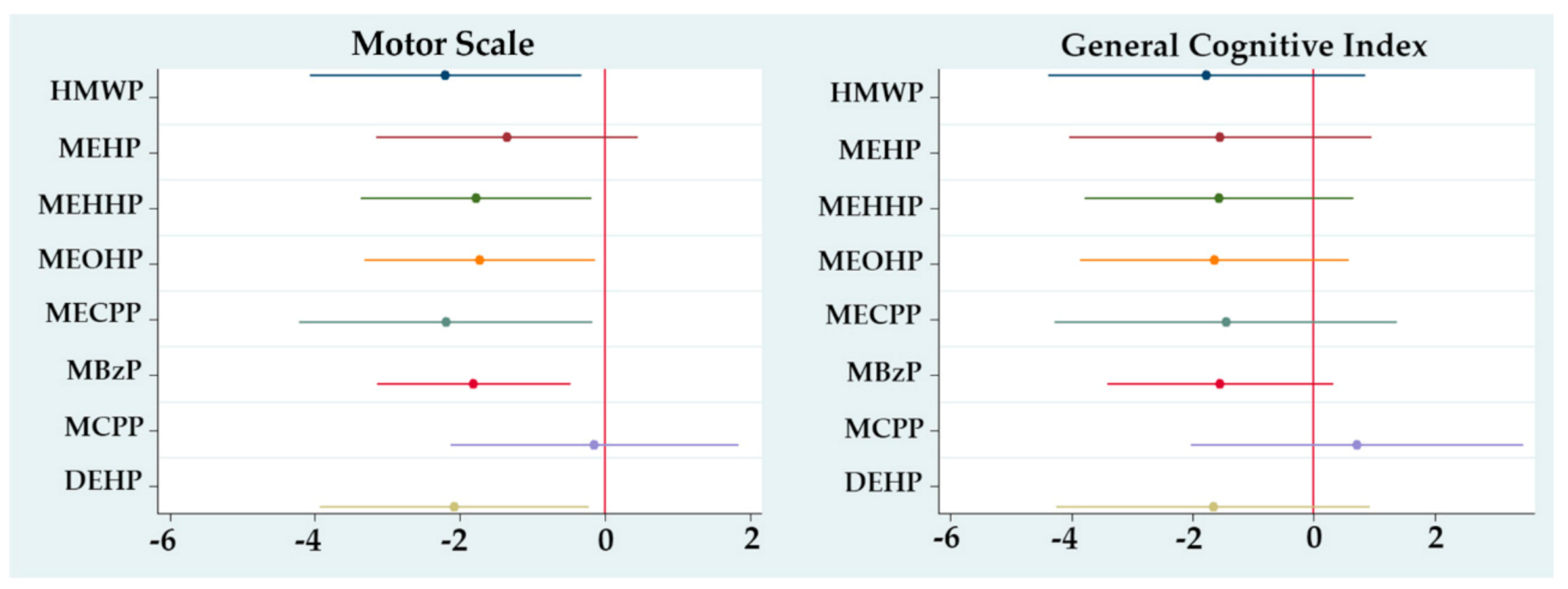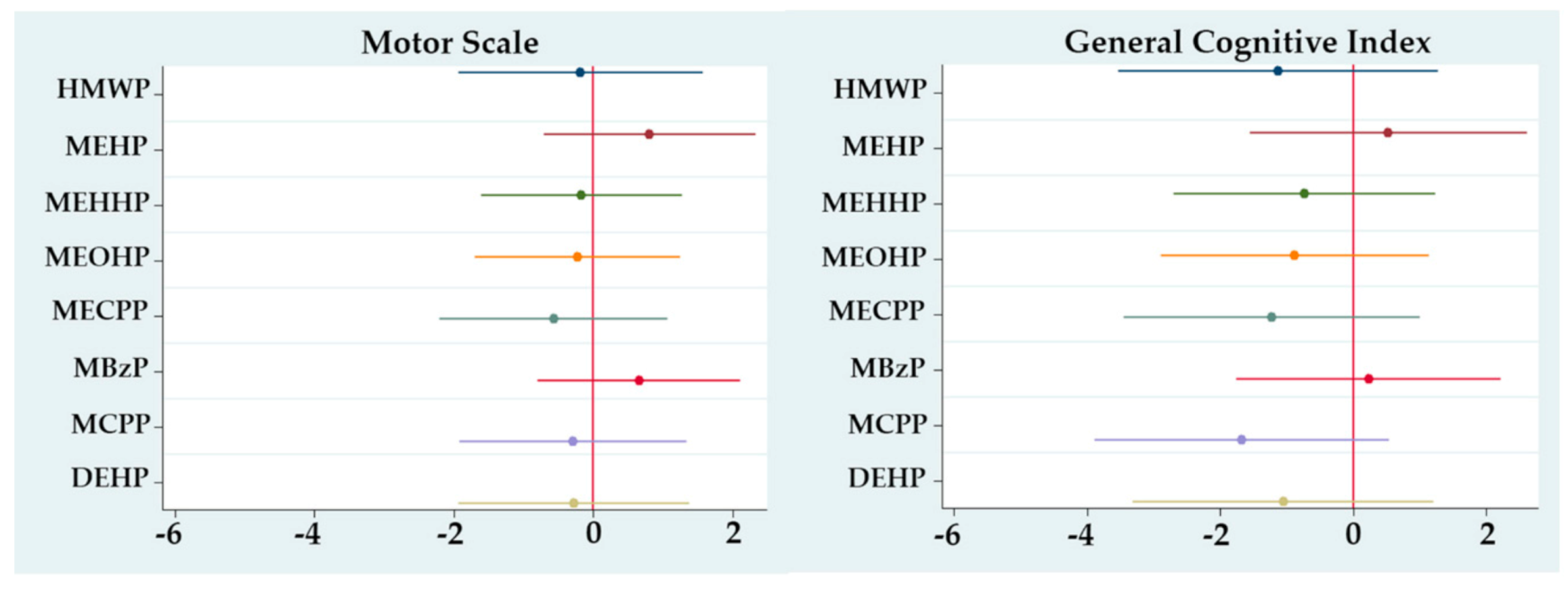Early Gestational Exposure to High-Molecular-Weight Phthalates and Its Association with 48-Month-Old Children’s Motor and Cognitive Scores
Abstract
:1. Introduction
2. Materials and Methods
2.1. Study Population
2.2. Phthalates
2.3. Children’s Neurodevelopment
2.4. Covariates
2.5. Statistical Analysis
3. Results
4. Discussion
5. Conclusions
Supplementary Materials
Author Contributions
Funding
Acknowledgments
Conflicts of Interest
References
- Stiles, J.; Jernigan, T.L. The basics of brain development. Neuropsychol. Rev. 2010, 20, 327–348. [Google Scholar] [CrossRef] [PubMed] [Green Version]
- Szpir, M. New thinking on neurodevelopment. Environ. Health Perspect. 2006, 114, A100–A107. [Google Scholar] [CrossRef] [PubMed] [Green Version]
- Halden, R.U. Plastics and health risks. Annu. Rev. Public Health 2010, 31, 179–194. [Google Scholar] [CrossRef] [PubMed] [Green Version]
- Johns, L.E.; Cooper, G.S.; Galizia, A.; Meeker, J.D. Exposure assessment issues in epidemiology studies of phthalates. Environ. Int. 2015, 85, 27–39. [Google Scholar] [CrossRef] [Green Version]
- Sapozhnikova, Y.; Hoh, E. Suspect screening of chemicals in food packaging plastic film by comprehensive two-dimensional gas chromatography coupled to time-of-flight mass spectrometry. LC GC NORTH Am. 2019, 37, 52–65. [Google Scholar]
- Kappenstein, O.; Vieth, B.; Luch, A.; Pfaff, K. Toxicologically relevant phthalates in food. Exp. Suppl. 2012, 101, 87–106. [Google Scholar] [PubMed]
- Schecter, A.; Lorber, M.; Guo, Y.; Wu, Q.; Yun, S.H.; Kannan, K.; Hommel, M.; Imran, N.; Hynan, L.S.; Cheng, D.; et al. Phthalate concentrations and dietary exposure from food purchased in New York State. Environ. Health Perspect. 2013, 121, 473–479. [Google Scholar] [CrossRef] [Green Version]
- Wang, Y.; Zhu, H.; Kannan, K. A review of biomonitoring of phthalate exposures. Toxics 2019, 7, 21. [Google Scholar] [CrossRef] [PubMed] [Green Version]
- Rocha, B.A.; Asimakopoulos, A.G.; Barbosa, F.; Kannan, K. Urinary concentrations of 25 phthalate metabolites in Brazilian children and their association with oxidative DNA damage. Sci. Total Environ. 2017, 586, 152–162. [Google Scholar] [CrossRef]
- Lewis, R.C.; Meeker, J.D.; Peterson, K.E.; Lee, J.M.; Pace, G.G.; Cantoral, A.; Téllez-Rojo, M.M. Predictors of urinary bisphenol A and phthalate metabolite concentrations in Mexican children. Chemosphere 2013, 93, 2390–2398. [Google Scholar] [CrossRef] [Green Version]
- González-Castro, M.I.; Olea-Serrano, M.F.; Rivas-Velasco, A.M.; Medina-Rivero, E.; Ordoñez-Acevedo, L.G.; de León-Rodríguez, A. Phthalates and bisphenols migration in mexican food cans and plastic food containers. Bull. Environ. Contam. Toxicol. 2011, 86, 627–631. [Google Scholar] [CrossRef]
- Silva, M.J.; Reidy, J.A.; Herbert, A.R.; Preau, J.L.; Needham, L.L.; Calafat, A.M. Detection of phthalate metabolites in human amniotic fluid. Bull. Environ. Contam. Toxicol. 2004, 72, 1226–1231. [Google Scholar] [CrossRef] [PubMed]
- Singh, A.R.; Lawrence, W.H.; Autian, J. Maternal-Fetal transfer of 14C-Di-2-ethylhexyl phthalate and 14C-diethyl phthalate in rats. J. Pharm. Sci. 1975, 64, 1347–1350. [Google Scholar] [CrossRef]
- Gao, N.; Hu, R.; Huang, Y.; Dao, L.; Zhang, C.; Liu, Y.; Wu, L.; Wang, X.; Yin, W.; Gore, A.C.; et al. Specific effects of prenatal DEHP exposure on neuroendocrine gene expression in the developing hypothalamus of male rats. Arch. Toxicol. 2018, 92, 501–512. [Google Scholar] [CrossRef]
- Holahan, M.R.; Smith, C.A. Phthalates and neurotoxic effects on hippocampal network plasticity. Neurotoxicology 2015, 48, 21–34. [Google Scholar] [CrossRef]
- Braun, J.M.; Sathyanarayana, S.; Hauser, R. Phthalate exposure and children’s health. Curr. Opin. Pediatr. 2013, 25, 247–254. [Google Scholar] [CrossRef] [Green Version]
- Chopra, V.; Harley, K.; Lahiff, M.; Eskenazi, B. Association between phthalates and attention deficit disorder and learning disability in USA children, 6–15 years. Environ. Res. 2014, 128, 64–69. [Google Scholar] [CrossRef] [Green Version]
- Téllez-Rojo, M.M.; Cantoral, A.; Cantonwine, D.E.; Schnaas, L.; Peterson, K.; Hu, H.; Meeker, J.D. Prenatal urinary phthalate metabolites levels and neurodevelopment in children at two and three years of age. Sci. Total Environ. 2013, 461–462, 386–390. [Google Scholar] [CrossRef] [Green Version]
- Radke, E.G.; Braun, J.M.; Nachman, R.M.; Cooper, G.S. Phthalate exposure and neurodevelopment: A systematic review and meta-analysis of human epidemiological evidence. Environ. Int. 2020, 137, 105408. [Google Scholar] [CrossRef]
- Qian, X.; Li, J.; Xu, S.; Wan, Y.; Li, Y.; Jiang, Y.; Zhao, H.; Zhou, Y.; Liao, J.; Liu, H.; et al. Prenatal exposure to phthalates and neurocognitive development in children at two years of age. Environ. Int. 2019, 131. [Google Scholar] [CrossRef]
- Zhang, Q.; Chen, X.Z.; Huang, X.; Wang, M.; Wu, J. The association between prenatal exposure to phthalates and cognition and neurobehavior of children—Evidence from birth cohorts. Neurotoxicology 2019, 73, 199–212. [Google Scholar] [CrossRef] [PubMed]
- Ejaredar, M.; Nyanza, E.C.; Ten Eycke, K.; Dewey, D. Phthalate exposure and childrens neurodevelopment: A systematic review. Environ. Res. 2015, 142, 51–60. [Google Scholar] [CrossRef] [PubMed]
- Engel, S.M.; Zhu, C.; Berkowitz, G.S.; Calafat, A.M.; Silva, M.J.; Miodovnik, A.; Wolff, M.S. Prenatal phthalate exposure and performance on the Neonatal Behavioral Assessment Scale in a multiethnic birth cohort. Neurotoxicology 2009, 30, 522–528. [Google Scholar] [CrossRef] [Green Version]
- Factor-Litvak, P.; Insel, B.; Calafat, A.M.; Liu, X.; Perera, F.; Rauh, V.A.; Whyatt, R.M. Persistent associations between maternal prenatal exposure to phthalates on child IQ at age 7 years. PLoS ONE 2014, 1–15. [Google Scholar] [CrossRef] [Green Version]
- Yolton, K.; Xu, Y.; Strauss, D.; Altaye, M.; Calafat, A.M.; Khoury, J. Prenatal exposure to bisphenol A and phthalates and infant neurobehavior. Neurotoxicol. Teratol. 2011, 33, 558–566. [Google Scholar] [CrossRef] [Green Version]
- Miodovnik, A.; Edwards, A.; Bellinger, D.C.; Hauser, R. Developmental neurotoxicity of ortho-phthalate diesters: Review of human and experimental evidence. Neurotoxicology 2014, 41, 112–122. [Google Scholar] [CrossRef]
- Philippat, C.; Bennett, D.H.; Krakowiak, P.; Rose, M.; Hwang, H.-M.; Hertz-Picciotto, I. Phthalate concentrations in house dust in relation to autism spectrum disorder and developmental delay in the childhood autism risks from genetics and the environment (CHARGE) study. Environ. Heal. 2015, 14, 56. [Google Scholar] [CrossRef] [Green Version]
- Benjamin, S.; Masai, E.; Kamimura, N.; Takahashi, K.; Anderson, R.C.; Faisal, P.A. Phthalates impact human health: Epidemiological evidences and plausible mechanism of action. J. Hazard. Mater. 2017, 340, 360–383. [Google Scholar] [CrossRef]
- Bliatka, D.; Lymperi, S.; Mastorakos, G.; Goulis, D.G. Effect of endocrine disruptors on male reproduction in humans: Why the evidence is still lacking? Andrology 2017, 5, 404–407. [Google Scholar] [CrossRef] [Green Version]
- Maqbool, F.; Mostafalou, S.; Bahadar, H.; Abdollahi, M. Review of endocrine disorders associated with environmental toxicants and possible involved mechanisms. Life Sci. 2016, 145, 265–273. [Google Scholar] [CrossRef]
- Watkins, D.J.; Peterson, K.E.; Ferguson, K.K.; Mercado-García, A.; Tamayo y Ortiz, M.; Cantoral, A.; Meeker, J.D.; Téllez-Rojo, M.M. Relating Phthalate and BPA Exposure to Metabolism in Peripubescence: The Role of Exposure Timing, Sex, and Puberty. J. Clin. Endocrinol. Metab. 2016, 101, 79–88. [Google Scholar] [CrossRef] [Green Version]
- Perng, W.; Tamayo-Ortiz, M.; Tang, L.; Sánchez, B.N.; Cantoral, A.; Meeker, J.D.; Dolinoy, D.C.; Roberts, E.F.; Martinez-Mier, E.A.; Lamadrid-Figueroa, H.; et al. Early life exposure in mexico to environmental toxicants (ELEMENT) project. BMJ Open 2019, 9, 30427. [Google Scholar] [CrossRef] [Green Version]
- National Reserach Council (US) Commitee on the Health Risks of Phthalates. Phthalate Exposure Assesment in Humans. Available online: https://www.ncbi.nlm.nih.gov/books/NBK215044/ (accessed on 10 September 2020).
- Atsdr. Toxicological Profile for Di(2-Ethylhexyl)Phthalate (DEHP) Draft for Public Comment; Atsdr: Atlanta, GA, USA, 2019. [Google Scholar]
- Horta, B.L.; Loret de Mola, C.; Victora, C.G. Breastfeeding and intelligence: A systematic review and meta-analysis. Acta Paediatr. 2015, 104, 14–19. [Google Scholar] [CrossRef]
- Kim, Y.; Ha, E.; Kim, E.; Park, H.; Ha, M.; Kim, J.; Hong, Y.; Chang, N.; Kim, B. Prenatal exposure to phthalates and infant development at 6 months: Prospective mothers and children’s environmental health (MOCEH) study. Environ. Health Perspect. 2011, 119, 1495–1500. [Google Scholar] [CrossRef] [PubMed] [Green Version]
- Polańska, K.; Jurewicz, J.; Hanke, W. Exposure to environmental and lifestyle factors and attention-deficit/hyperactivity disorder in children—A review of epidemiological studies. Int. J. Occup. Med. Environ. Health 2012, 25, 330–355. [Google Scholar] [CrossRef]
- Doherty, B.T.; Engel, S.M.; Buckley, J.P.; Silva, M.J.; Calafat, A.M.; Wolff, M.S. Prenatal phthalate biomarker concentrations and performance on the Bayley Scales of Infant Development-II in a population of young urban children. Environ. Res. 2017, 152, 51–58. [Google Scholar] [CrossRef] [Green Version]
- Gascon, M.; Valvi, D.; Forns, J.; Casas, M.; Martínez, D.; Júlvez, J.; Monfort, N.; Ventura, R.; Sunyer, J.; Vrijheid, M. Prenatal exposure to phthalates and neuropsychological development during childhood. Int. J. Hyg. Environ. Health 2015, 218, 550–558. [Google Scholar] [CrossRef]
- Balalian, A.A.; Whyatt, R.M.; Liu, X.; Insel, B.J.; Rauh, V.A.; Herbstman, J.; Factor-Litvak, P. Prenatal and childhood exposure to phthalates and motor skills at age 11 years. Environ. Res. 2019, 171, 416–427. [Google Scholar] [CrossRef] [PubMed]
- Cho, S.C.; Bhang, S.Y.; Hong, Y.C.; Shin, M.S.; Kim, B.N.; Kim, J.W.; Yoo, H.J.; Cho, I.H.; Kim, H.W. Relationship between environmental phthalate exposure and the intelligence of school-age children. Environ. Health Perspect. 2010, 118, 1027–1032. [Google Scholar] [CrossRef]
- Silva, M.J.; Samandar, E.; Preau, J.L.; Reidy, J.A.; Needham, L.L.; Calafat, A.M. Quantification of 22 phthalate metabolites in human urine. J. Chromatogr. B. Analyt. Technol. Biomed. Life Sci. 2007, 860, 106–112. [Google Scholar] [CrossRef]
- Bradley, E.L. Determination of Phthalates in Foods and Establishing Methodology to Distinguish their Source; Food Standards Agency: London, UK, 2012. [Google Scholar]
- Buckley, J.P.; Kim, H.; Wong, E.; Rebholz, C.M. Ultra-processed food consumption and exposure to phthalates and bisphenols in the US National Health and Nutrition Examination Survey, 2013–2014. Environ. Int. 2019, 131. [Google Scholar] [CrossRef] [PubMed]
- Lin, C.-H.; Chen, T.-J.; Chen, S.-S.; Hsiao, P.-C.; Yang, R.-C. Activation of Trim17 by PPARγ is involved in Di(2-ethylhexyl) phthalate (DEHP)-induced apoptosis on Neuro-2a cells. Toxicol. Lett. 2011, 206, 245–251. [Google Scholar] [CrossRef]
- Jo, J.-Y.; Kim, T.-H.; Jeong, H.-Y.; Lim, S.-M.; Kim, H.-S.; Im, D.-S. Effect of Di-(2-ethylhexyl)-phthalate on sphingolipid metabolic enzymes in rat liver. Toxicol. Res. 2011, 27, 185–190. [Google Scholar] [CrossRef] [PubMed] [Green Version]
- Borch, J.; Metzdorff, S.B.; Vinggaard, A.M.; Brokken, L.; Dalgaard, M. Mechanisms underlying the anti-androgenic effects of diethylhexyl phthalate in fetal rat testis. Toxicology 2006, 223, 144–155. [Google Scholar] [CrossRef]
- Quoc, N.; Tran, V.; Miyake, K. Neurodevelopmental disorders and environmental toxicants: Epigenetics as an underlying mechanism. Int. J. Genom. 2017. [Google Scholar] [CrossRef] [Green Version]
- y Ortiz, M.T.; Téllez-Rojo, M.M.; Trejo-Valdivia, B.; Schnaas, L.; Osorio-Valencia, E.; Coull, B.; Bellinger, D.; Wright, R.J.; Wright, R.O. Maternal stress modifies the effect of exposure to lead during pregnancy and 24-month old children’s neurodevelopment. Environ. Int. 2017, 98, 191–197. [Google Scholar] [CrossRef] [Green Version]



| Characteristics | Participants n = 218 | Nonparticipants * n = 431 |
|---|---|---|
| Mother | (mean ± SD) | (mean ± SD) |
| Age(years) | 26.8 ± 5.7 | 26.5 ± 5.3 |
| Education (years) | 11.0 ± 2.8 | 10.0 ± 2.2 |
| Maternal IQ | 92.1 ± 20.9 | 88.6 ± 20.7 a |
| Child | ||
| Female (%) | 53.2 | 49.4 |
| Gestational Age (weeks) | 39.2 ± 4.3 | 38.7 ± 4.3 |
| Anthropometry | ||
| Birth Weight (kg) | 3.2 ± 0.4 | 3.1 ± 0.4 |
| Birth Length (cm) | 50.2 ± 2.0 | 49.7± 3.5 b |
| Exclusive Breastfeeding (weeks) | 8.1 ± 5.9 | 7.7 ± 5.8 c |
| McCarthy Scales of Children’s Abilities Scores 1 | ||
| General Cognitive Index (GCI) | 97.5 ± 13.0 | 97.2 ± 13.7 |
| Motor Scale (MS) | 45.5 ± 9.2 | 46.1 ± 9.9 |
| Memory Scale (MeS) | 48.7 ± 6.5 | 46.6 ± 7.1 |
| HOME 2 | 35.2 ± 6.6 d | 35.8 ± 5.6 e |
| Metabolite (ng/L) | First Trimester n = 188 (Mean ± SD) | Second Trimester n = 189 (Mean ± SD) | Third Trimester n = 214 (Mean ± SD) |
|---|---|---|---|
| High Molecular Weight (HMWP) | |||
| MEHP | 9.5 ± 12.5 | 7.8 ± 10.6 | 8.4 ± 11.8 |
| MEHHP | 30.5 ± 30.3 | 32.5 ± 72.1 | 30.5 ± 31.2 |
| MEOHP | 16.3 ± 15.8 | 19.4 ± 41.4 | 18.4 ± 19.0 |
| MECPP | 48.6 ± 42.3 | 55.4 ± 144.0 | 46.7 ± 43.0 |
| MBzP * | 6.6 ± 10.1 | 4.6 ± 5.6 | 7.3 ± 10.7 |
| MCPP ** | 2.4 ± 7.4 | 1.6 ± 1.4 | 1.7 ± 1.8 |
| General Cognitive Index | Motor Scale | |||
|---|---|---|---|---|
| Boys n = 77 | Girls n = 90 | Boys n = 77 | Girls n = 90 | |
| Metabolite | ß † (95% CI) | ß † (95% CI) | ß † (95% CI) | ß † (95% CI) |
| HMWP 1 | −3.4 (−7.1, 0.3) | −0.6 (−4.1, 2.9) | −3.2 * (−6.1, −0.4) | −2.5 * (−4.9, −0.2) |
| MEHP | −3.1 (−6.2, 0.1) | −0.1 (−3.1, 3.0) | −3.0 * (−5.4, −0.5) | −1.7 (−3.8, 0.3) |
| MEHHP | −2.1 (−5.0, 0.9) | −0.2 (−3.3, 2.9) | −2.2 (−4.5, 0.1) | −2.2 * (−4.3, −0.1) |
| MEOHP | −2.2 (−5.2, 0.8) | −0.4 (−3.5, 2.7) | −2.3 (−4.6, −0.0) | −2.1 * (−4.2, −0.0) |
| MECPP | −2.7 (−6.5, 0.9) | −0.2 (−3.8, 3.4) | −2.4 (−5.3, 0.5) | −2.4 * (−4.8, −0.0) |
| MBzP | −2.5 * (−4.9, −0.1) | −1.3 (−3.6, 1.0) | −2.3 * (−4.2, −0.5) | −0.5 (−2.0, 1.1) |
| MCPP | −1.9 (−5.9, 2.2) | 0.3 (−2.5, 3.2) | −1.9 (−5.1, 1.2) | −0.5 (−2.4, 1.5) |
| ∑ DEHP 2 | −3.1 (−6.8, 0.5) | −0.3 (−3.8, 3.2) | −2.9 * (−5.7, −0.1) | −2.5 * (−4.8, −0.2) |
Publisher’s Note: MDPI stays neutral with regard to jurisdictional claims in published maps and institutional affiliations. |
© 2020 by the authors. Licensee MDPI, Basel, Switzerland. This article is an open access article distributed under the terms and conditions of the Creative Commons Attribution (CC BY) license (http://creativecommons.org/licenses/by/4.0/).
Share and Cite
Torres-Olascoaga, L.A.; Watkins, D.; Schnaas, L.; Meeker, J.D.; Solano-Gonzalez, M.; Osorio-Valencia, E.; Peterson, K.E.; Tellez-Rojo, M.M.; Tamayo-Ortiz, M. Early Gestational Exposure to High-Molecular-Weight Phthalates and Its Association with 48-Month-Old Children’s Motor and Cognitive Scores. Int. J. Environ. Res. Public Health 2020, 17, 8150. https://doi.org/10.3390/ijerph17218150
Torres-Olascoaga LA, Watkins D, Schnaas L, Meeker JD, Solano-Gonzalez M, Osorio-Valencia E, Peterson KE, Tellez-Rojo MM, Tamayo-Ortiz M. Early Gestational Exposure to High-Molecular-Weight Phthalates and Its Association with 48-Month-Old Children’s Motor and Cognitive Scores. International Journal of Environmental Research and Public Health. 2020; 17(21):8150. https://doi.org/10.3390/ijerph17218150
Chicago/Turabian StyleTorres-Olascoaga, Libni A., Deborah Watkins, Lourdes Schnaas, John D. Meeker, Maritsa Solano-Gonzalez, Erika Osorio-Valencia, Karen E. Peterson, Martha María Tellez-Rojo, and Marcela Tamayo-Ortiz. 2020. "Early Gestational Exposure to High-Molecular-Weight Phthalates and Its Association with 48-Month-Old Children’s Motor and Cognitive Scores" International Journal of Environmental Research and Public Health 17, no. 21: 8150. https://doi.org/10.3390/ijerph17218150





